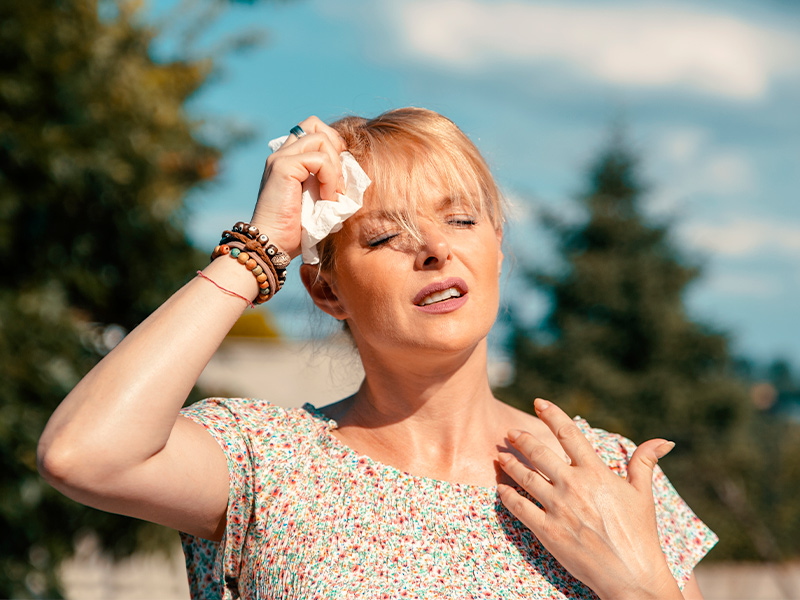How to avoid heat exhaustion and heatstroke on hot days
Overheating on a hot day can lead to heat exhaustion or, even worse, heatstroke. Here’s how to protect yourself and your family during a heatwave.
Staying cool during hot weather is not just about being comfortable – it’s essential for preventing serious health issues such as heat exhaustion or heatstroke.
Fyowna Norton, manager of State Emergency Services for the Red Cross in Victoria, says it’s important that people understand the impact heat can have on wellbeing, and plan accordingly.
“While heat waves are a part of Australian summers, they can have really serious effects on people,” Fyowna told The House of Wellness radio.
In fact, Fyowna points out heat waves have caused more deaths in Australia than any other disaster.
- Rest easy: How to get a good night’s sleep in the heat
What’s the difference between heat stroke and heat exhaustion?
Despite sounding similar, heat exhaustion is a less severe form of overheating than heat stroke.
“Heatstroke is the most extreme version of our body losing control of its thermos-regulating ability and is a serious medical emergency,” clinical nutritionist, Dr Vincent Candrawinata, says.
“Heat exhaustion, while also a serious condition that needs intervention, is not as damaging.”
What is heat exhaustion?
“Heat exhaustion is caused by the body overheating – caused by dehydration, excessive activity, or even normal activity in high heat,” Fyowna explains.
Signs of heat exhaustion include headache, a body temperature of more than 40 degrees, muscle cramps, exhaustion and general weakness, nausea/vomiting, dizzy spells, a week or rapid pulse, or pale, cool, clammy skin which becomes flushed and red.
What is heatstroke?
Heatstroke, explains Fyowna, is a life threatening condition.
“Heatstroke can cause someone to collapse or become unconscious,” she says.
“You might see the same symptoms as you would in heat exhaustion, but the person may become confused, be very red, hot, flustered, and in extreme cases they may be vomiting. “They can also stop sweating.”
Heat stroke is caused by overheating.
Common signs of heatstroke include:
- headache, dizziness, nausea, vomiting and confusion
- having flushed, hot and unusually dry skin
- being extremely thirsty
- having a dry, swollen tongue
- having a sudden rise in body temperature to more than 40°C
- being disoriented or delirious
- slurred speech
- being aggressive or behaving strangely
- convulsions, seizures or coma.
- may be sweating and skin may feel deceptively cool
- rapid pulse
Who is most at risk of heat-related illness?
Everyone should ensure they’re avoiding overexposure to the sun at all times, cautions Fyowna.
“High heat days can be dangerous for anyone, but particularly younger people, older people, and people who work outdoors and those who may have a medical condition,” she says.
How to manage and prevent heat-related illness
It’s important to make a plan for extreme heat events, says Fyowna.
“Learn about heatwaves, forecasts, and if you have a medical condition, how heat might impact the condition,” she says.
“Make your house cooler, install cooling, air conditioners, or go somewhere that has cooling, or find out where there are free water fountains in your area, and use shade.”
You can also take dietary measures to look after yourself on hot days.
“Drinking plenty of water is very important,” Fyowna says.
“Sugary drinks can make dehydration worse.
“Eat small meals more often, eat cooler foods, such as salads and fruits to help keep body temperature down.”
Also remember to keep an eye on your vulnerable neighbours and look after your pets during extreme heat events.
- Hydration rules: How much water should you drink each day?
How to manage heatstroke
If someone is suffering from heatstroke, Dr Vincent suggests removing excess clothing and finding a cooler place.
You can also use an ice bath or cooling blanket.
“If you’re able to cool down within 30 minutes, heat exhaustion isn’t typically considered an emergency,” Dr Vincent says.
- However, if there are no signs of improvement, immediately ring 000.
- Sweet treat: Coconut water and fresh fruit ice lollies
Words by Alexandra Feiam





